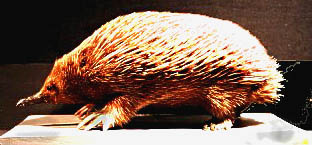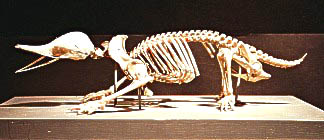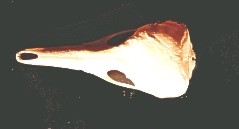
The short-beaked echidna (Tachyglossus aculeatus) is found throughout Australia and southern New Guinea. The males grows to a length of about 30 cm and weighs up to 7 kg; the females are slightly smaller. Echidnas can live for up to 45 years. Echidnas live in forests, woodlands, deserts and mountains. They are generally crepuscular (most active at dusk and dawn) and nocturnal. In winter, they become torpid or hiberate and are rarely seen. The echidna's coat is made of coarse hairs and spines (modified hairs)
that feel like finger nails. The spines are large and hollow walled for
insulation; underneath the spines, the animal is covered in fur. The fur
varies in colour from blond to black; most echidnas are dark. The echidna
also has a short tail which is easier to see in the skeleton. When an animal
feels threatened, it will burrow into the ground leaving the spines sticking
out to deter any further attacks. Male echidnas have spurs and venom glands
but they are non-functional.
The short-beaked echidna has a long sticky tongue perfect for catching ants, its main prey, termites and insect larvae. The tongue and the roof of the mouth are covered with spines to grind up insect skeletons, making it easier for the animal to digest its food. Echidnas are solitary animals, only coming together during the
mating season, which lasts from two to three weeks in July to August.
During this time, the female is followed by a 'train' of males; eventually
she choses a mate but how is not known. The female usually gives birth to
only one leathery egg. The egg is placed into a 'pouch' made by folds of
skin, where it hatches after ten days. The foetus has an egg tooth, like
reptiles and birds, which it uses to break open the leathery eggshell. The
young feeds by licking milk from secretory patches on the mother's skin. It
is carried in the pouch until its spines begin to grow when the mother places
it in a nursery burrow hollowed in the ground. She returns frequently to feed
the young echidna, which becomes independent in a year.
|










